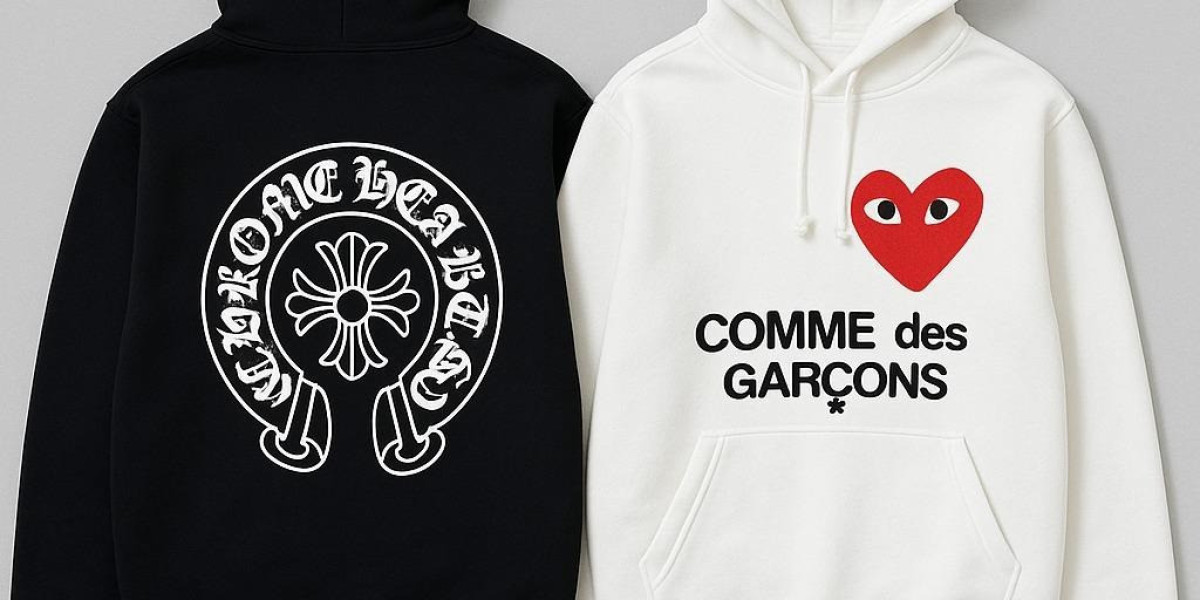Fashion has always been a silent language—one that communicates identity, emotion, and defiance without the need for words. Two brands that have mastered this art of nonverbal communication are Comme des Garçons and Chrome Hearts. While both come from vastly different origins—one rooted in avant-garde Japanese minimalism and the other born from American rock-and-roll maximalism—they share a common thread: rebellion. Together, they represent two sides of fashion’s countercultural voice, pushing boundaries, questioning norms, and proving that clothing can be far more than fabric—it can be a philosophy.
In this article, we’ll explore how Comme des Garçons and Chrome Hearts individually built their legacies as symbols of defiance, and how their shared ethos has reshaped what it means to communicate through style in a world obsessed with conformity.
Comme des Garçons: The Avant-Garde Language of Deconstruction
Founded in Tokyo in 1969 by Rei Kawakubo, Comme des Garçons has long been synonymous with disruption. At a time when fashion was focused on glamour and structure, Kawakubo introduced asymmetry, imperfection, and a deliberate rejection of traditional beauty. Comme des Garçons wasn’t just another label—it was a statement against everything the fashion industry believed in.
What made Comme des Garçons revolutionary wasn’t just the clothes but the philosophy behind them. Each collection of https://commedesgarcon.org/ told a story—sometimes chaotic, sometimes poetic—but always intentional. Kawakubo believed in using design as a medium for thought, turning garments into wearable art. Torn fabrics, exaggerated silhouettes, unfinished hems, and dark color palettes weren’t signs of rebellion for shock value—they were acts of intellectual defiance.
The brand’s debut in Paris in the early 1980s shocked the fashion world. Critics described the collection as “Hiroshima chic,” a term that reflected both the misunderstanding and fascination it provoked. What others saw as destruction, Kawakubo saw as creation. By deconstructing garments, she redefined the very meaning of beauty and perfection in fashion.
Comme des Garçons communicates through contrast—beauty and ugliness, order and chaos, visibility and obscurity. This tension forms the language of the brand: a visual dialect of rebellion that invites viewers to question not just how they dress, but why.
Chrome Hearts: The Rock-and-Roll Code of Luxury Rebellion
If Comme des Garçons whispers rebellion through deconstruction, Chrome Hearts shouts it through unapologetic excess. Founded in Los Angeles in 1988 by Richard Stark, Chrome Hearts began as a brand catering to custom leather pieces for rock musicians. Over time, it evolved into one of the most exclusive luxury labels in the world—yet it has never lost its outlaw soul.
Chrome Hearts’ aesthetic is instantly recognizable: heavy sterling silver jewelry, gothic crosses, dagger motifs, fleur-de-lis embellishments, and intricate craftsmanship. Each piece speaks a language rooted in individuality, freedom, and defiance of mainstream luxury. It’s luxury for those who refuse to conform—a visual manifesto that merges rebellion with refinement.
Unlike most high-end brands that rely on mass visibility, Chrome Hearts thrives on secrecy and exclusivity. There are no flashy ad campaigns, no influencer collaborations, and no widespread availability. Every boutique of https://chromeheartshoodie-us.com/ is designed like a fortress of personality—dark wood, silver accents, and custom furniture—each reflecting the brand’s commitment to individuality. The result is a cult-like following among musicians, artists, and fashion outsiders who understand that wearing Chrome Hearts isn’t about fashion—it’s about identity.
What makes Chrome Hearts powerful is its authenticity. It doesn’t chase trends or seasons. Instead, it crafts objects meant to last a lifetime, echoing a time when style was personal and raw. The brand’s use of premium materials—handmade leather, gold, silver, and rare woods—transforms rebellion into craftsmanship, making defiance not just an attitude but an art form.
The Intersection of Two Rebellious Worlds
At first glance, Comme des Garçons and Chrome Hearts seem worlds apart—one minimalist and cerebral, the other maximalist and visceral. Yet beneath their stylistic differences lies a shared philosophy: to challenge the status quo. Both brands reject the idea of fashion as a passive consumer experience. Instead, they treat it as a dialogue—one between the wearer, the creator, and society itself.
While Comme des Garçons dissects fashion to reveal its conceptual bones, Chrome Hearts reconstructs it into something fiercely personal. Both are driven by authenticity and a refusal to cater to trends. Their rebellion is not about shock but about freedom—freedom from definition, expectation, and convention.
The synergy between them lies in how they communicate without words. When someone wears Comme des Garçons, they’re not simply making a style choice—they’re making a statement about thought, individuality, and nonconformity. Similarly, wearing Chrome Hearts isn’t about brand recognition; it’s about embracing the boldness of being unapologetically oneself. Both speak the same language: the language of rebellion, translated through design.
Symbolism in Design: Speaking Through Form and Material
The power of both brands lies in their symbolism. Comme des Garçons uses shape and absence as its vocabulary. Oversized jackets, irregular cuts, and layered fabrics are metaphors for imperfection and freedom. They express an emotional honesty that challenges the artificial perfection often celebrated in mainstream fashion.
Chrome Hearts, on the other hand, communicates through material and motif. Its weighty silver accessories and leather garments embody permanence and strength. The cross and dagger motifs aren’t religious symbols—they’re declarations of resilience, courage, and individuality. Every engraving, every handcrafted link, and every piece of leather carries meaning—a reminder that rebellion can be both elegant and eternal.
Together, these design philosophies teach that communication in fashion doesn’t require words. It requires intent. Whether it’s Comme des Garçons’ intellectual abstraction or Chrome Hearts’ visceral craftsmanship, each uses its medium to express a worldview—a visual language for those who think and feel differently.
Cultural Impact: From Subculture to Global Influence
The rebellious language of Comme des Garçons and Chrome Hearts has transcended niche fashion circles to influence global culture. Comme des Garçons has become a touchstone for avant-garde fashion enthusiasts, artists, and designers who seek to explore the boundaries of expression. Its influence can be seen in modern streetwear, conceptual art, and even architecture—fields where imperfection and experimentation are celebrated.
Chrome Hearts, meanwhile, has redefined luxury for a generation that values authenticity over logos. Its crossover into music, film, and art has cemented its status as the brand of choice for creative rebels. From rock icons like The Rolling Stones to modern artists and designers, Chrome Hearts has become a symbol of individuality that bridges subculture and sophistication.
Both brands have achieved what few others can: they have built cult identities without sacrificing artistic integrity. Their appeal lies not in accessibility but in exclusivity of spirit. They attract those who see fashion as a reflection of the self rather than a performance for others.
The Shared Philosophy of Silent Expression
At their core, Comme des Garçons and Chrome Hearts share an understanding that clothing is communication. They prove that style can carry emotion, ideology, and resistance. Their silent dialogue with the world is powerful precisely because it transcends verbal expression.
For Rei Kawakubo, rebellion comes from questioning everything—even the concept of beauty itself. For Richard Stark, rebellion comes from creating luxury that rejects superficial glamour. Yet both share a respect for craft and an unwavering commitment to authenticity. In a culture driven by mass production and trend cycles, these brands stand as monuments to individuality and artistic courage.
The collaboration between intellect and instinct—the cerebral minimalism of Comme des Garçons and the visceral luxury of Chrome Hearts—creates a balance that speaks to modern rebels who crave meaning in fashion. They remind us that rebellion doesn’t always scream; sometimes, it simply refuses to explain itself.
Why Their Language Resonates Today
In a world where social media dictates taste and uniformity dominates, the silent rebellion of Comme des Garçons and Chrome Hearts feels refreshing—and necessary. Their ability to speak without words challenges the current narrative of fashion as fast, loud, and temporary.
Comme des Garçons encourages introspection: it asks wearers to find beauty in imperfection. Chrome Hearts encourages assertion: it invites wearers to express power through craftsmanship. Together, they create a dialogue between vulnerability and strength, intellect and emotion.
This duality resonates with today’s generation, who seek authenticity and depth in what they wear. Fashion has become less about belonging and more about being—and both brands embody that shift perfectly.







